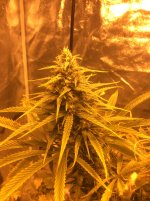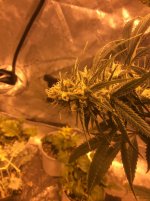Rained steady last two days. I topped up my black trash can and all my 5 gallons are nearly full. A few more tubs fillled as well. It was an effort to empty and carry around containers. I seem to be moderately healthy lately so I was able to do it. Still not fun sadly.
My rain read 5ppm. I added a bit of nutes and raised it to 215. PH measured 6.6, after some time. Took this thing a while to stop and it never really stopped. It just hovered around 6.5 - 6.6xxx . My plant continues to thicken up.
Does anyone have a ballpark guess as to gallons of water per plant? I’m trying to think ahead for next grow. I’m going to scale back up a bit and grow 4 plants.
My rain read 5ppm. I added a bit of nutes and raised it to 215. PH measured 6.6, after some time. Took this thing a while to stop and it never really stopped. It just hovered around 6.5 - 6.6xxx . My plant continues to thicken up.
Does anyone have a ballpark guess as to gallons of water per plant? I’m trying to think ahead for next grow. I’m going to scale back up a bit and grow 4 plants.




